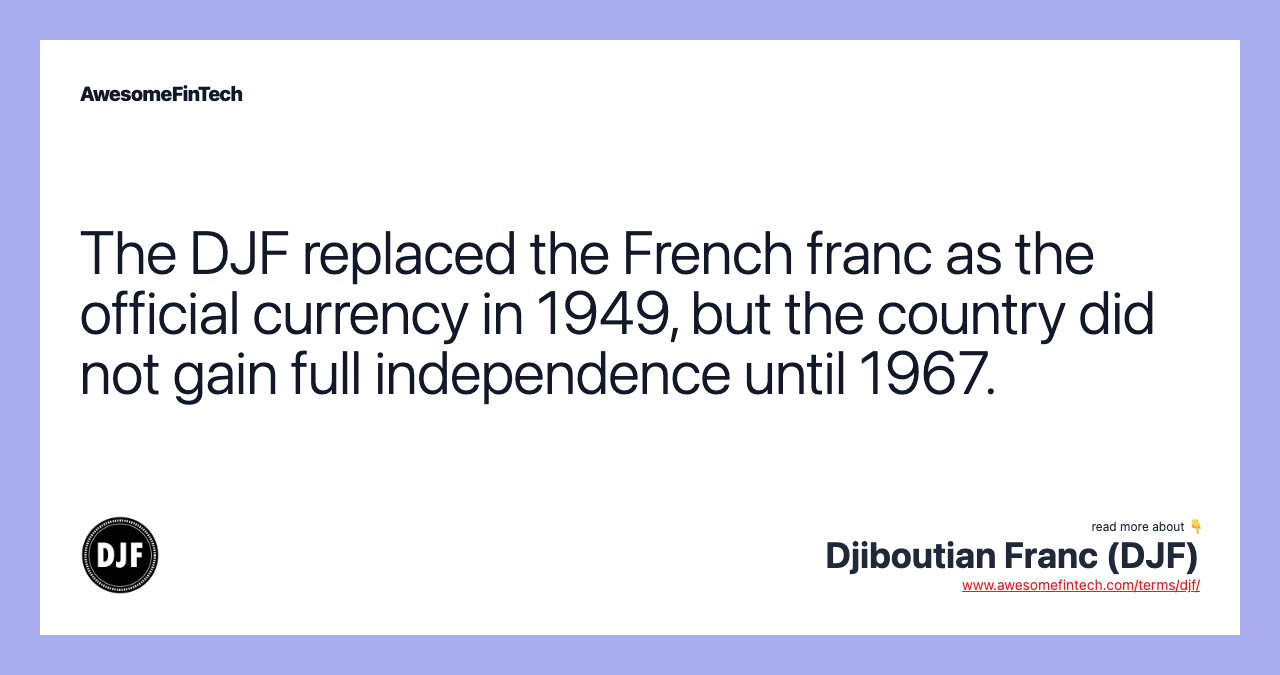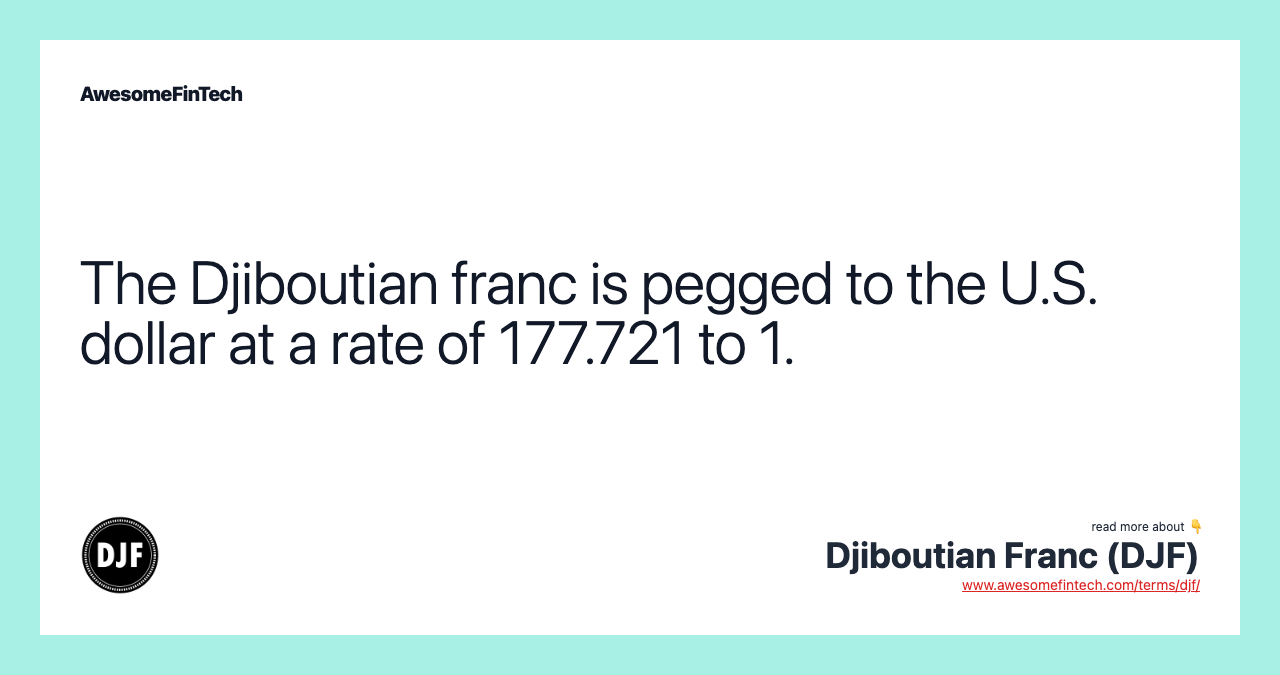Djiboutian Franc (DJF)
The DJF is the ISO currency code for the Djiboutian franc, which is the official currency of the African country of Djibouti. Depending on estimates, anywhere from two-thirds to three-quarters of all Djibouti’s citizens reside in its capital city; the majority of the remainder are nomads trying to scratch out a living as shepherds, herders, or farmers. For 2019, the country’s unemployment rate was estimated at less than 11%. However, that’s much less dire than the 60% rate of unemployment that was estimated for 2014. Nevertheless, the rate of youth unemployment continues to be problematic; it was estimated at nearly 21% for 2020. For 2019 The Djiboutian franc is pegged to the U.S. dollar at a rate of 177.721 to 1. When Djibouti became part of the French protectorate in 1884, the French _franc_ was introduced to Djibouti and was used in exchange along with According to currency rankings, the most commonly used Djibouti franc exchange rate is the EUR/DJF rate. The DJF is the ISO currency code for the Djiboutian franc, which is the official currency of the African country of Djibouti.

What Is the Djiboutian Franc (DJF)?
The DJF is the ISO currency code for the Djiboutian franc, which is the official currency of the African country of Djibouti. The Djibouti franc is pegged to the U.S. dollar (USD) at a rate of $1 to 177.721 DJF.



Understanding the Djiboutian Franc (DJF)
When Djibouti became part of the French protectorate in 1884, the French franc was introduced to Djibouti and was used in exchange along with the Indian rupee (INR) and the Maria Theresa thaler. In 1908, the first Djiboutian franc appear and was issued at par against the French franc, with banknotes issued by the Bank of Indochina starting in 1910.
The modern Djibouti franc was not introduced until 1949 when it was pegged against the U.S. dollar at an exchange rate of 1 USD = 214.392 DJB. The country gained full independence from France in 1967, and in the early 1970s, the DJB was revalued at a rate of 1 USD = 177.721 DJB, where it remains today.
The Banque Centrale de Djibouti issues and manages the DJF. Coins are minted in denominations of 500, 250, 100, 50, 20, 10, 5, 2 and 1 franc. Banknotes are printed in 1,000, 2,000, 5,000 and 10,000 DJF denominations. According to currency rankings, the most commonly used Djibouti franc exchange rate is the EUR/DJF rate.
Djibouti’s Economy
With fewer than one million citizens and geographically smaller than the state of New Jersey, the Republic of Djibouti is a tiny but strategically located nation. It is situated between the Gulf of Aden and the Red Sea and is the gateway to the Suez Canal, one of the world’s busiest shipping lanes. Djibouti is also sandwiched between Somalia and Ethiopia.
Despite its strategic location, Djibouti continues to be one of the poorest countries in the world. The country receives almost no rainfall, and according to 2016 data, less than 1% of its landmass is suitable for agriculture due to the lack of arability. At the same time, Djibouti has little in the way of natural resources, such as oil, minerals, or forest products, so it lacks in industry and export commodities beyond animal hides and skins and scrap metal. As a result, services and taxes connected to its deepwater port facilities reportedly account for more than 75% of the country’s gross domestic product (GDP). Djibouti also relies heavily on foreign aid to fund its balance of payments and development projects.
Depending on estimates, anywhere from two-thirds to three-quarters of all Djibouti’s citizens reside in its capital city; the majority of the remainder are nomads trying to scratch out a living as shepherds, herders, or farmers. For 2019, the country’s unemployment rate was estimated at less than 11%. However, that’s much less dire than the 60% rate of unemployment that was estimated for 2014. Nevertheless, the rate of youth unemployment continues to be problematic; it was estimated at nearly 21% for 2020. For 2019, the country's GDP grew at an annual rate of 7% with inflation at 2.39%.
Related terms:
CFP Franc (XPF)
The CFP Franc (XPF) is the official currency of the French territories of the Pacific: New Caledonia, French Polynesia, Wallis, and Futuna. read more
Currency Peg
A currency peg is a policy in which a national government sets a specific fixed exchange rate for its currency. Learn the pros and cons of currency pegs. read more
ETB (Ethiopian Birr)
The Ethiopian birr (ETB), the national currency of the Federal Democratic Republic of Ethiopia, is issued by the National Bank of Ethiopia. read more
Foreign Exchange (Forex)
The foreign exchange (Forex) is the conversion of one currency into another currency. read more
Gross Domestic Product (GDP)
Gross domestic product (GDP) is the monetary value of all finished goods and services made within a country during a specific period. read more
Indian Rupee (INR)
The Indian rupee is the currency of India; its currency code is INR. Discover the types of coins, notes, and how the central bank manages the rupee. read more
Comorian Franc (KMF)
Learn more about the Comorian franc, the currency of Comoros, an island nation in the Indian Ocean near Africa. read more
Lebanese Pound (LBP)
LBP is the currency code for the Lebanese pound, the currency of Lebanon. read more
Oman Rial (OMR)
OMR is the currency symbol for the Omani rial, the currency of the Sultanate of Oman, which is pegged to the U.S. dollar. read more
Serbian Dinar (RSD)
The RSD (Serbian dinar) is the ISO currency code for the official currency of the Republic of Serbia and is subdivided into 100 paras. read more